
30 longwing brogues, made by shoemakers from all over the world. Here’s a substantial review of all the competition shoes that entered the World Championships in Shoemaking 2022. Info about the makers and the shoes, comments, pictures of the shoes and in some cases also the manufacturing process.
It has taken some time, thank you for your patience, now the summary of all contestant shoes 2022 is finished. Loads of work to put it together, and loads of shoe greatness for you to go through.
Part of the London Super Trunk Show at the end of May was the second edition of the World Championships in Shoemaking, organised by Shoegazing and The Shoe Snob. It was set-up in collaboration with online retailer Kirby Allison, book project Master Shoemakers, and private person Parker Schenecker, brother of the shoe aficionado Edmund Schenecker who sadly passed away last year. These contribute with the substantial prize money of £3,000 to winner, £2,000 to second placed and £1,000 to third placed (note that we organisers don’t make any money at all on this contest, the money is paid directly from the partners to the shoemakers). Also they receive one handmade awl made to their specifications, by Phil Norsworthy.
The top three shoes also will go on tour around the world now (together with the winning shoes in the patina championship), to be showcased for as many shoe lovers as possible. We have a mix of some new locations and stores, and some that have been part of the tours previous years (the plan is to continue to vary the tour from year to year). The shoes will also be showcased on the super trunk shows in Stockholm on September 24 and in Amsterdam October 1. The preliminary tour schedule is as follows, and potentially new dates can be added:
| Week | Date | Store | City, country |
| w27 | July 5 | Kirby Allison | Dallas, USA |
| w28-29 | July 12-24 | The Armoury | New York, USA |
| w31-32 | Aug 2-14 | The Armoury | Hong Kong |
| w34-35 | Aug 23-Sep 4 | Mason & Smith | Singapore |
| w37-38 | Sept 13-23 | Loake store | Stockholm, Sweden |
| w40 | Oct 4-9 | The Hand | Amsterdam,Netherlands |
| w41-42 | Oct 14-23 | Isetan Men’s | Tokyo, Japan |
| w44-45 | Nov 1-13 | Medallion Shoes | Beijing, China |
| w46-47 | Nov 17-27 | Medallion Shoes | Shanghai, China |
| w49-50 | Dec 6-18 | Unipair | Seoul, South Korea |
| w1-2 | Jan 3-15 | Oak Room | Taipei, Taiwan |
| w4-5 | Jan 24-Feb 5 | TBA | Australia |
At the London Super Trunk Show all competition shoes were on display for the almost 1,200 people who visited the event during the day, and at the award ceremony in the evening the top ten were presented. The shoes and the competition once again gained a huge interest and admiration, and also afterwards the attention has been big. It’s great that the shoemaking community has taken this competition to their hearts, giving it and the contestants well-deserved recognition. As we’ve said before, it takes guts to send in a shoe for review and put your efforts on display like this. It’s a great thing that all shoemakers, both the once who have done this for many years and the real beginners, all say that they’ve made the best shoe they ever have for the contest, and learned a lot from the making of it, things they normal production will benefit from. We could see that there was fewer beginners and such who sent in shoes, the overall level was higher than previous contests. Which in a way is good not least for those who want to see superb craftsmanship, rather than shoes made by people early in the development.
The day before the event the shoes were reviewed anonymously by the jury, which consisted of:
Daniel Wegan, bespoke shoemaker, winner 2019
Jean-Michel Casalonga, bespoke shoemaker, workshop manager Berluti
Nicholas Templeman, bespoke shoemaker
Masaru Okuyama, bespoke shoemaker
Sebastian Tarek, bespoke shoemaker
Kirby Allison, founder of the Kirby Allison webshop
Gary Tok, author of Master Shoemakers
Jesper Ingevaldsson, Shoegazing
Justin FitzPatrick, The Shoe Snob
From the jury review in London the day before the super trunk event. Here’s Nicholas Templeman and Daniel Wegan.
The criteria that were set out for the competition shoes were as follows:
– Longwing brogue derby model (4-6 separate leather pieces, brogueing along all main edges of the leather pieces, wingtip and medallion is mandatory, further decorative brogueing and decorations are ok though not necessary, but no contrast stitching)
– One left shoe, size UK8 (or corresponding size), maximum 2 width sizes up or down from an acceptable standard width
– Reddish brown / burgundy box calf upper (aniline dyed leather)
– Leather sole
– Hand welted, handmade sole stitch
– Dark sole and heel edges, natural coloured bottom (decorations with for example wheels or nails are ok, but no dye or burnish)
– Finished inside of the shoe, with sock lining etc.
– No branding
– Shoes will be displayed without last or shoe tree for the jury, but if shoe tree is provided these will be used when they are showcased during the event
Errors in respect to the above specifications will result in deductions of points, 5% deduction of total points for small errors, 10% deduction of total points on larger errors. If the shoe does not follow specifications at all, it can be disqualified. Jury decisions on the above cannot be overruled.
The criteria that the jury reviewed, were the following:
Degree of difficulty (maximum 10 points per jury member)
Jury look at how complicated construction methods that have been used, how advanced they have been built both in large and in smaller details, etc.
Execution (maximum 10 points)
Jury look at how well the various parts of the shoe construction have been made, how neat and clean the work is, how well executed the level of finishing is, etc.
Design / Aesthetics (maximum 5 points)
Jury look at the overall aesthetics of the shoe, proportions, etc.
So, below first the full list of results, then a walkthrough of all competition shoes, from position 1 to 30 (1-10 in this post, 11-30 in another post). The level of many of the shoes are superb, and it’s worth noting it was extremely tight this year, for example, between 1 and 3 it was only 12 points (192 to 180), and outside the podium even tighter, between position 4 and 14 there were only 22 points. There’s more pictures and text on the top position shoes, especially now with so many entries I had to do things a bit more condensed to make it workable, but all have a brief summary and at least 4 pictures of the shoes from various angles. In some cases of the top 10 shoes I’ve also included pictures of the making process. Click the pictures to see larger versions, to really get a look at some of the wonderful details that’s to be found.
The Participants (this post focuses on 1-10 with the rest to follow in part 2):
1. Wataru Shimamoto
2. Ken Kataoka
3. Kenjiro Kawashima
4. Christophe Corthay
5. Tatsuya Kamikubo
6. Yun Ji-hoon
7. Hiroshi Takagi
8. Clematis Ginza
9. Nathan Hwang
10. Koji Endo
11. Andrey Kaveshnikov
12. Oh Sang-Jun
13. Masayuki Kaneko
14. Yasuhiro Koui
15. Valentin Frunza
16. Marat Ablakov
17. Peace Andoh
18. Efe Laborde Bootmaker
19. Meisterschuh Berlin
20. Lu Yang Bespoke
21. Raz Maftei / Maszschuhe
22. Dmitry Avdyukhov
23. Emi Liao
24. Enrile
25. Guseynov
26. The Last Shoemaker
27. Koji Yamaya
28. Ganbaatar Batjarga
29. Robert Elia
30. Fan Yi
.
1. Wataru Shimamoto
Perhaps the most toned down winning shoe we’ve had in the three world championship contests, which doesn’t instantly overwhelm you with some artistic details (like the extremely narrow waist and super thin heel stacks of Patrick Frei’s winning shoe, or the super narrow width and ridge shaped back of Daniel Wegan’s shoe). Obviously you see that it’s a beautiful piece of footwear that the Japanese Wataru Shimamoto has created, very well-made, but it’s first when you start looking closer that you discover many of the features of the shoe and realise how it’s more or less made to absolute perfection.
Both Frei’s and Wegan’s shoes were very well-made, but degree of difficulty were a more important factor in their wins, sort of the opposite here for Shimamoto where the shoe of course has a high degree of difficulty in how its made, but where it really excelled is in the execution part – and the design. It’s a superb pattern, so well-balanced and thought through in every single line, and paired perfectly with last shape, sole thickness, heel shape, and so on.
If we start looking closer at the shoe, what have to be mentioned is perhaps the thing that few would have noticed at first, but that was one of the main challanges for Shimamoto when making the shoe: the fact that the two main parts are cut out from pieces lasted as seamless wholecuts.
– there were more than 10 failed seamless wholecuts before I got everything right, Wataru Shimamoto says.
– I think I spent more than 100 hours on the finished product. On top of that, I was constantly thinking about the competition shoe for three months during the production, starting with the design concept, then all details during the process.
The back, where you can see that there’s no back seams on any piece. With the peaked shape of the heel to add character.
So, the two main parts of the shoe, the toe going back to the heel, and the vamp and quarters, are not just made of one piece each as on all longwing derbys, they are made without seams. Normally, there’s a seam in the back – here, there’s no such. To achieve this one basically have to make a seamless wholecut, where a single piece of leather is pulled over the last and all creases meticulously lasted out. This becomes one of the parts, then one have to do it again, and make the other part. Not easy to get all things perfect with this procedure, and time consuming. When we decided on the longwing as the model for this round of the contest, we hoped this type of upper making would be one thing we’d see, since it’s a pattern making it possible, and gladly there were a few who went this route.
Other parts worth highlighting is the tight, very finely executed sole stitching at 20 spi (stitches per inch), the horseshoe heel with its slightly asymmetric peak shape, and the lovely metal toe and heel taps. These are made by Takafumi Mochizuki (who also assisted with the shoe tree, which isn’t part of the contest though), otherwise everything is made by Wataru Shimamoto himself. And he says the work with the contest shoe definitely has developed him as a shoemaker:
– It’s about not giving up and constantly trying to make things better. I also think even more about how the pattern can enhance the shape of the shoe, he explains.
As mentioned above, the execution of the making of his shoe is absolute top class. Every little detail is made to perfection, not least the finishing which is so clean, distinct and crisp. For those who remember last year’s contest we had Eiji Murata’s beautiful entry that came in third place, which was similarly executed to perfection, now when done on a shoe where the level of difficulty is raised as well, it managed to reach all the way to the top.
Well-made heel, with gorgeous brass heel plate made out of two pieces, where the smaller one is completely sunken into the heel.
Wataru Shimamoto is from the Kanagawa district, south of Tokyo. During his college studies he started making shoes by himself in his spare time, and after graduation he worked in a shoe repair shop for three years. He was then clear that shoes what was he wanted to spend his life working with. He moved to Florence, Italy, and got an apprenticeship with Hidetaka Fukaya, the man behind the famous bespoke shoemaking brand Il Micio. One can definitely see that Wataru has trained under Hidetaka, for example in the elongated lasts with accentuated aggressive toe shapes, and in other ways. Wataru Shimamoto worked at Il Micio for several years, becoming one of their main bottom makers.
A couple of years ago he moved back to Japan to focus on his own brand Orma Shoemaker, working out of a workshop in Kamakura City in Kanagawa. In the first world champs in shoemaking in 2018 he finished 4th with a really lovely shoe (you can see it here), where you can see that he had his identity already there with a similar last shape and the slightly pointy heel. No doubt that he has developed as a maker since then do, and that he he put in more efforts for this shoe. Efforts rewarding him with a gold medal.
More photos of the masterpiece.
The upper is machine stitched, showing that one still can go all the way in this contest also with a more traditional way of making the upper.
Here if one look close one can see that some extra stress have been put on the leather due to it being lasted as seamless wholecuts over the shoe. But lasting work has been done superbly.
We’ll continue with seeing some photos from the making of the winning shoe. Here is Wataru Shimamoto in his workshop.
The finished tree. Pictures: Wataru Shimamoto
.
2. Ken Kataoka
Japanese Ken Kataoka’s shoe is spectacular, for obvious reasons. A serious exhibition piece. It is created to attract the eye, whether one like how it looks or not, you have to look at it, and you have to pick it up and examine it. Which really is a good feature for a contest shoe. With many parts inspired by French shoes from early 1900’s or thereabout, then exaggerated and with a lot of personal details added. The oversized high heel as well as its low cut makes for a feminine feel, certainly a different interpretation of a longwing full brogue, while still complying with all guidelines set out.
The heel consists of no less than 32 lift pieces, and the shape of it is splendid. The way the outsole follows along the heels inside all the way to outs bottom, creating a sort of extended ridge fiddle back waist, can surely be described as art. This feel continues with the gold pattern that goes around the entire shoe, also on the sole, and the fine gold painted gimping and brogue holes unites it all into a lovely whole. Fine sole stitching, gorgeous hand braided upper stitching. Execution is excellent, extra impressive given that Ken Kataoka is relatively new in shoemaking.
I met Ken Kataoka the first time when me and Patrick Frei visited Isetan Men’s for an exhibition event of the top three in the world champs in shoemaking 2018. He was there together with some fellow students from one of the shoemaking college’s in Tokyo, and he was studying the shoes extremely carefully. I met him again the year after when I was at the bespoke maker Noriyuki Misawa and he were there for a shoemaking class, and have heard stories from among others Daniel Wegan how Ken has joined friends ordering from Daniel to measurings and fittings where he just watch the process and takes notes, all to learn as much as possible. You can see this dedication in this shoe.
– I spent about 150 hours on making the shoe, and what I’m happy about is that it sort of re-confirmed for me that shoemaking really is what I love doing, especially when I can be as creative and challenged as I’ve been here, Ken Kataoka says.
Today Ken runs the brand Sireono Yosui, currently a one man operation, even if he is looking for a new person to work with after Toshide Takai left.
Read more about Ken Kataoka and Siroeno Yosui in this article, and here I highlight the excellent Youtube films they’ve done extensively showing how the shoes are made.
Beautifully decorated uppers, note especially the hand braided stitching. This took more than two days to achieve, and according to Ken it was the hardest part to make, along with getting the balance right.
And from behind you can see that he didn’t quite managed to make it fully balanced from all views. It is a bit tilted.
Here’s Ken Kataoka talking to world champion 2018, Patrick Frei, about his winning shoe when it was exhibited at Isetan Men’s in Tokyo. Now Ken will have his own shoe part of an exhibition there, and around the world.
Start of the upper making, where the decoration pattern has been wheeled on and brogue hole markings marked out.
The upper first has regular machine stitched seams, and on these he then braided, by hand, a more decorative seam. Tedious work.
Sole stitching. As you can se, he has in a clever ways split the back part of the sole, where one part is continued on as a regular outsole towards the back, the thinner top part is used to cover the front part of the heel.
Heel building in an early stage. He apparently built the base heel first, so at one point this was a regular shoe with higher heel, then extended to an extremely high heel.
Finishing the sole. Pictures: Ken Kataoka
.
3. Kenjiro Kawashima
The most “classic” longwing of the top trio, which has more of the chunkier feel that the model is associated with, even if it still has an elegant feel over it. It’s a shoe where it feels like Kenjiro Kawashima has actually used every idea that popped into his head, making a packed piece of footwear with lots of things going on with it. For example you have the Norwegian stitching with the high, gimped storm welt which gives the shoe its firm base, and of course the lovely handmade split and lift-stitching upper stitching. It’s also a very well-balanced shoe, objectively beautiful one might say, and similar to Shimamoto it’s done with two parts of the upper made seamless.
What I also love about the shoe is the asymmetric heel, which has the outside front part brought out tapering outwards, which in a clever way gives a necessary fuller body of the back of the shoe to balance up the front part, while still making the blind welted ridge fiddle back waist possible. On the bottom we also find very well-made nail decorations in the back and front. For Kenjiro Kawashima, who made the shoe himself, the playfulness of making a contest shoe has been rewarding:
– I think that being able to challenge complicated manufacturing methods and ideas that are not usually done in making shoes for customers is a great achievement for my own experience, he says.
Look at the stance of the shoe, with the forward leaning longwing following the line of forward leaning last shape from the vamp down to the toe that dives into the storm welted Norwegian stitching.
Kenjiro Kawashima is based in Seoul, South Korea, but also comes from Japan originally. Today he both makes shoes under his own name as well as doing bespoke shoes for Norman Vilalta. He lived in Barcelona and trained and worked for Vilalta during three years, before moving to South Korea. He is part of a new wave of bespoke shoemakers in South Korea, not least seen here in the contest where we had many entries from this country.
Most makers who enter this contest spent a lot of work to develop the shoe. Kenjiro Kawashima shared a bit of this process, here where he has different nail patterns tested out.
Trying out things for the upper making. He also had ideas about gold coloured brogeuing, as you can see in the back.
Unlike Shimamoto, Kawashima could use only one seamless upper for his shoe, given that he stitched the upper edge towards edge.
Building the heel. Pictures: Kenjiro Kawashima
.
4. Christophe Corthay
The famous French shoemaker Christophe Corthay has participated in every world championship this far, beginning with an 8th place, finished 2nd previous round, and this year ending up just outside the podium. As always, a wonderfully playful shoe with creative elements one rarely see in shoemaking. I’m particularly fond of how he has build a “heavy rubber sole pattern”, but with loads of small stacked leather pieces. It’s a shoe combining a chunkier make with a more elegant last, creating a special look. It has an extremely thick, multi-layered sole with several layers of sole stitching, creating the most massive of sole edges. The ghillie closing and turqoise accent coloured details adds character. As always from Christophe Corthay, all are very well made, and he’s done all parts himself.
Christophe Corthay is a famous name in the shoemaking world. Having worked alongside his brother Pierre with Maison Corthay for several years, he left to continue on his own a number of years ago. Together with Christophe Algans he runs the Atelier du Tranchet/Tranchet Vif project, where they apart from shoes also makes other excellent artistic pieces of leather.
What the sole pattern is made of. Pictures: Christophe Corthay
.
5. Tatsuya Kamikubo
On 5th place we have a shoe by Japanese Tatsuya Kamikuba with several cool and unique things part of it. The sole has been decorated with some sort of special stitch prick (I assume) which gives the welt a very special look, mathed perfectly with the contrasting sole stitch. Also, it’s done with a 360° sole stitch, but with a very neat one around the heel, and in between we have a blind welted waist. Here we also have one who’ve used seamless pieces, with a bit special design where the facing is made of the same piece as the quarters and vamp.
Tatsuya Kamikuba is, impressively enough, actually not a full time shoemaker. He works as a mechanical engineer, then during evenings and weekends he makes shoes. During four years he trained all weekends with Yasuhiro Saito, a Japanese repairman and shoemaker. Now he takes orders and do shoes on the side of his regular job. When one can achieve stuff to this level, in a way one can feel the world deserves to have him work full time with shoes.
The vamp, quarter and facing piece. Pictures: Tatsuya Kamikuba
.
6. Yun Ji-Hoon
Yun Ji-Hoon from South Korea is another shoe with a massive bottom part. Four-threaded Norwegian stitching and then a type of braided sole stitch. The heel is extremely massive, one could use it as a hammer, and then the longwing sides has some really cool waves which are going over the quarter part up above the top piece for a three dimensional look. This bottom part of the upper is also seamless. I don’t know much about Yun Ji-Hoon unfortunately, but he has made the entire shoe himself.
.
7. Hiroshi Takagi
Right after the heaviest heel of the contest, we have the sleekest one. It sits on the shoe of Japanese Hiroshi Takagi, and his very well-made entry. Especially on execution he received high points, for example look at the super tight and perfectly made sole stitching. One of the best of these in the contest. A bit less on difficulty and design, a bit of lack in balance for example with the fuller front and then narrow waist and super small heel. The whole shoe was made by Hiroshi Takagi.
Good work to not get any marks from awl or needle when having this overhang at the blind welt waist.
.
8. Clematis Ginza
One of the more famous Japanese makers who participated, Clematis Ginza is the brand of the duo Keitaro Takano (lasts and bottom making) and Chiemi Chiba (pattern making and closing). Together with Guild of Crafts they are the biggest Japanese names who do distinctly Japanese style shoes, instead of the more European influenced (and often European trained) colleagues. This is evident in their beautiful entry in the contest as well. Many characteristics from their shoes can be found, like the asymmetric last shape, the “blooming lacing” that goes from dark to lighter colour, and the leaf shaped heel top piece (although more aggresively shaped and in metal here compared to their regular shoes). A cool feature is how the sole stitching is completely hidden in the welt, so it’s not visible either from top or below. A shoe made with a lot of skill.
The shoe tree they made was done of scrap sole leather (shoe trees are not part of the judging, hence why there’s no pics of these).
Here closer to being finished. Pictures: Clematis Ginza
.
9. Nathan Hwang
An ambitious shoe where a lot of work has gone into it, scoring high both on difficulty and execution but less on design, making Nathan Hwang lose out one or two positions. It’s not a bad looking shoe, but the very short vamp and the long facing, together with the solution of the quarter, throws balance off a bit, and it also has a rather anonymous last shape. Craftsmanship is super though, with hand stitched finely made upper with 16 spi stitching and lots of parts braided in a classy way. Sole stitching at 19 spi is also nicely executed. Nathan Hwang has trained and worked both at Stefano Bemer and at Gaziano & Girling’s bespoke department, though he now is back in South Korea.
A nice S shape of the breast of the heel, and slight ridge on the waist, which has a bevelled inside and square outside.
Have so say I appreciate a classic square edge waist edge, especially when sole stitching is as well-made as here.
He did an interesting thing on the inside of the heel, where he embedded a separate leather piece to sort of achieve the look of a mark from a branch on wood. A cool little detail.
.
10. Koji Endo
Koji Endo is a Japanese maker that has been around for a long time. Learned the basics in Japan, before spending time in France with Anthony Delos. Has run his own brand out of Japan now for many years. Lots of things to admire on his entry, like the decorative stitching just above the heel, the sunken outer edge of the bottom of the sole, the hand braided details on the upper, and so on. It’s a bit funny to see the similar use of tassel patterns as Delos had on his entry in the contest last round, here found on the side of the facing and out of brass nails on the toe part of the sole.
Bottom filling. Here you can also see that the stitching at the back is started already at this stake with a separate piece below the upper.








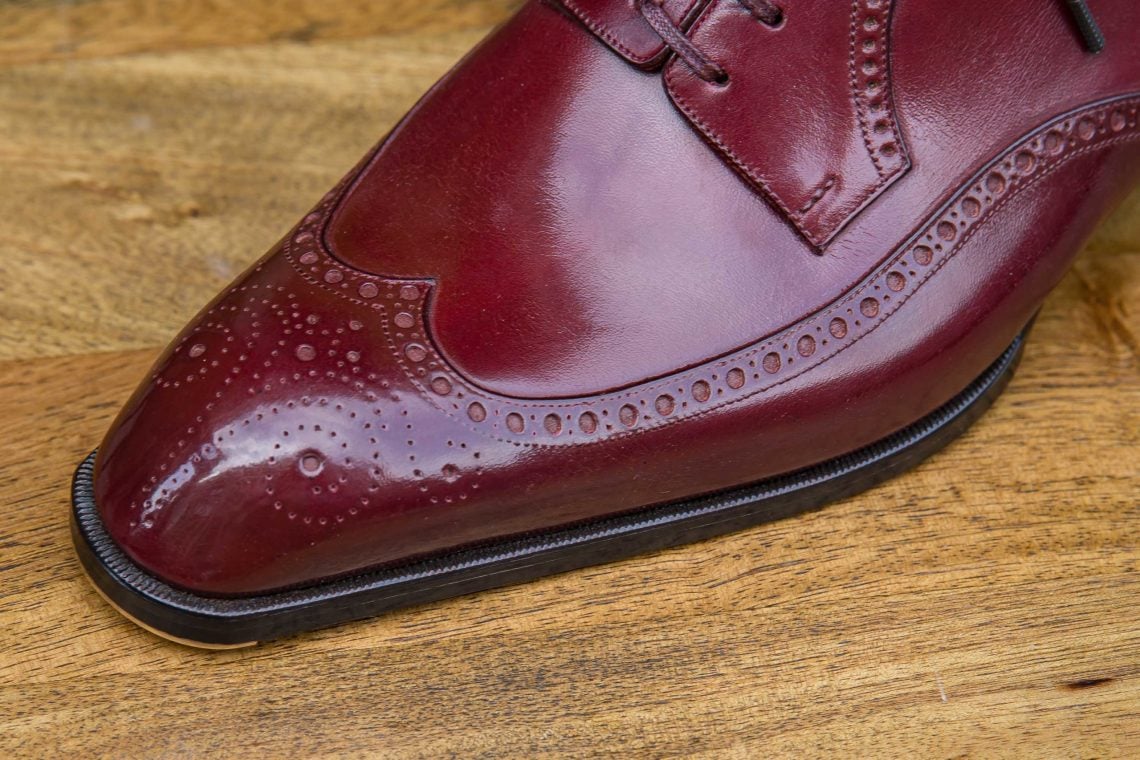



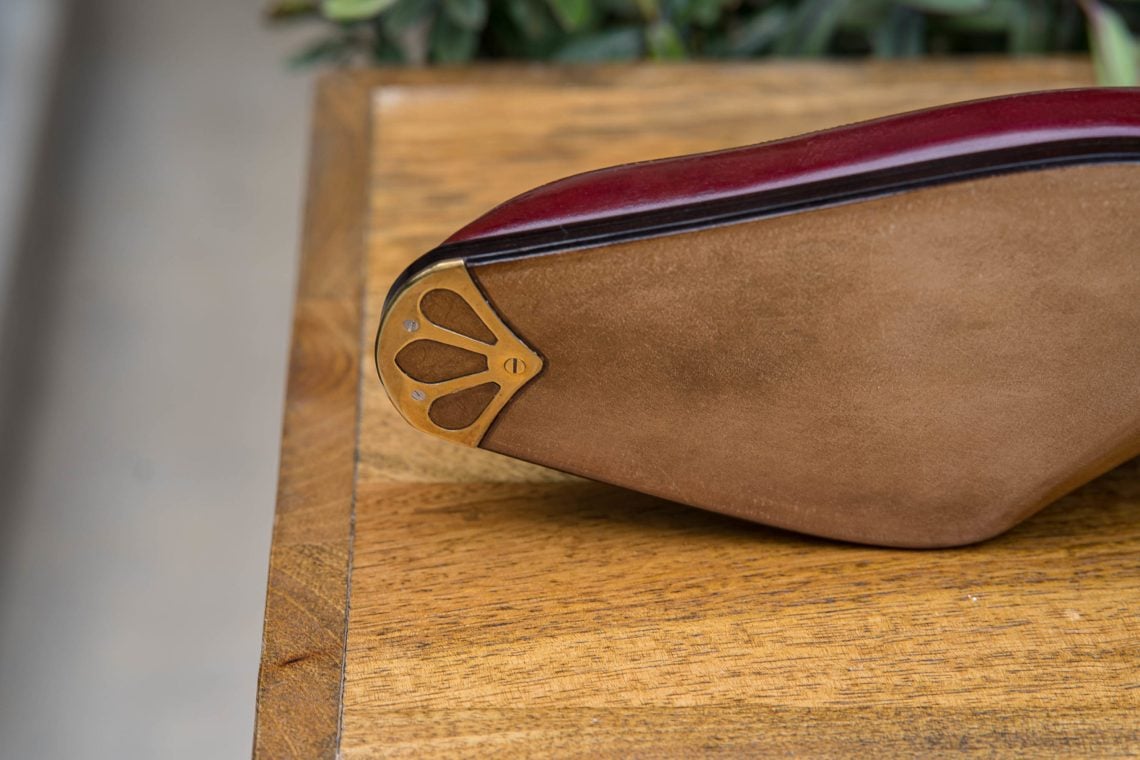






















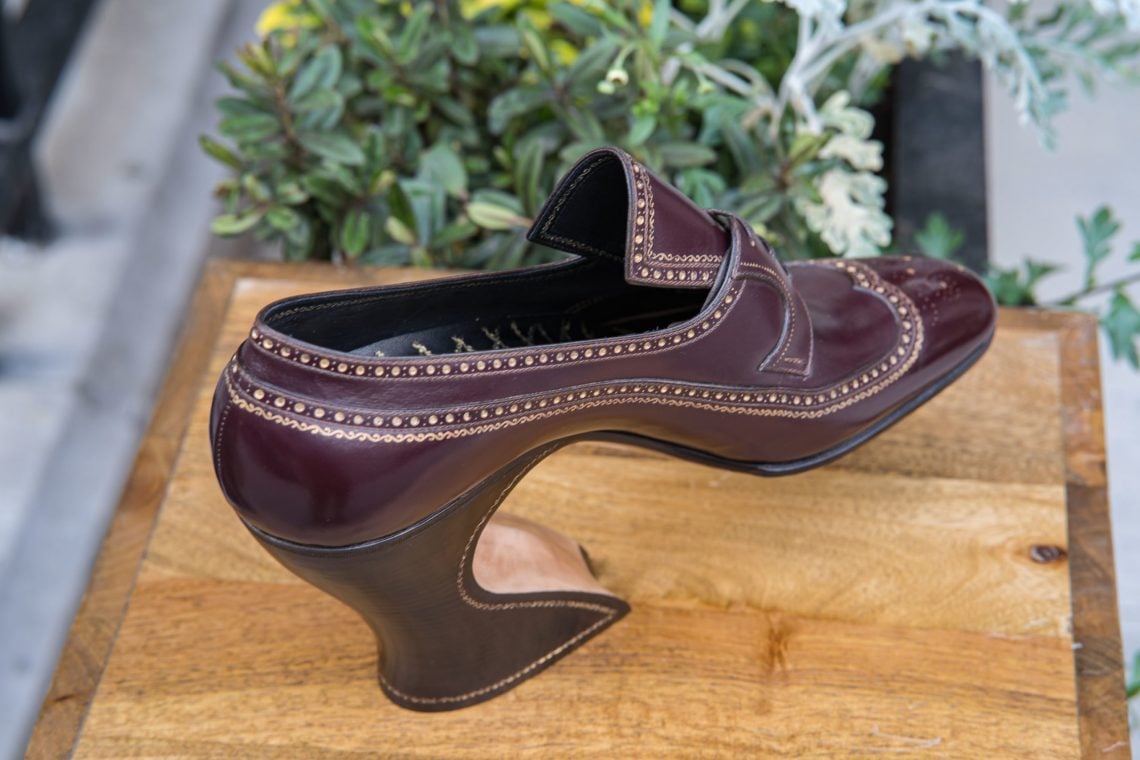


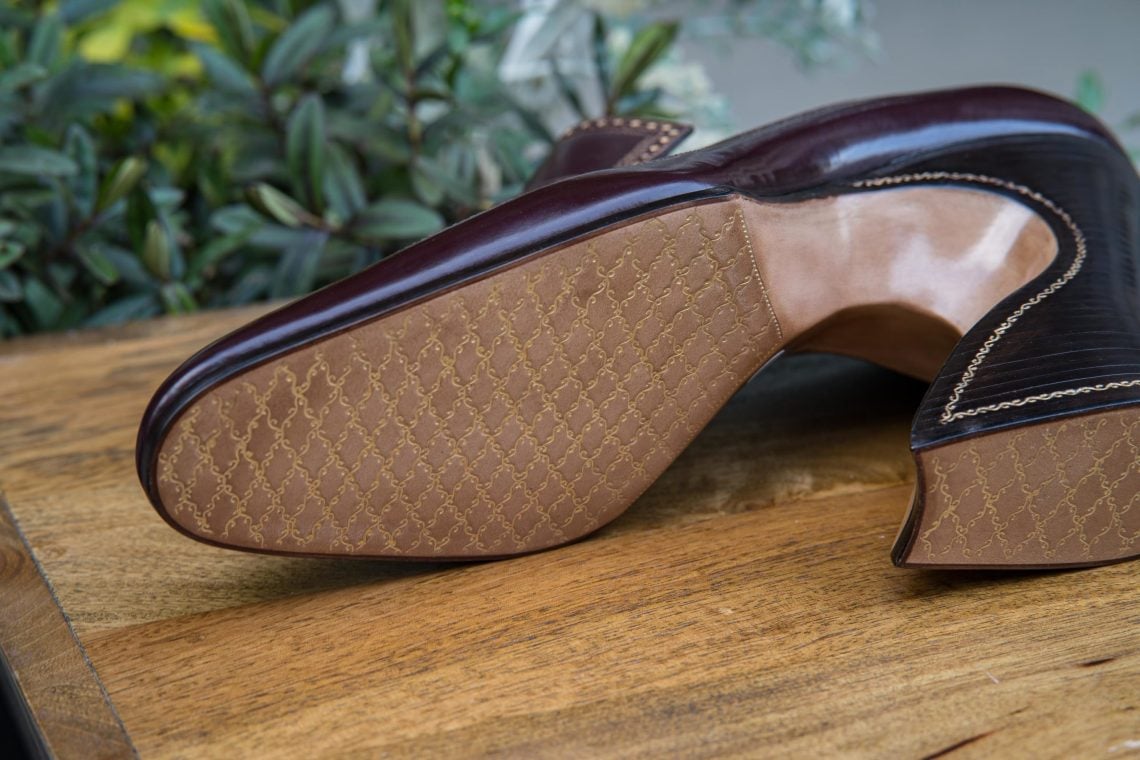





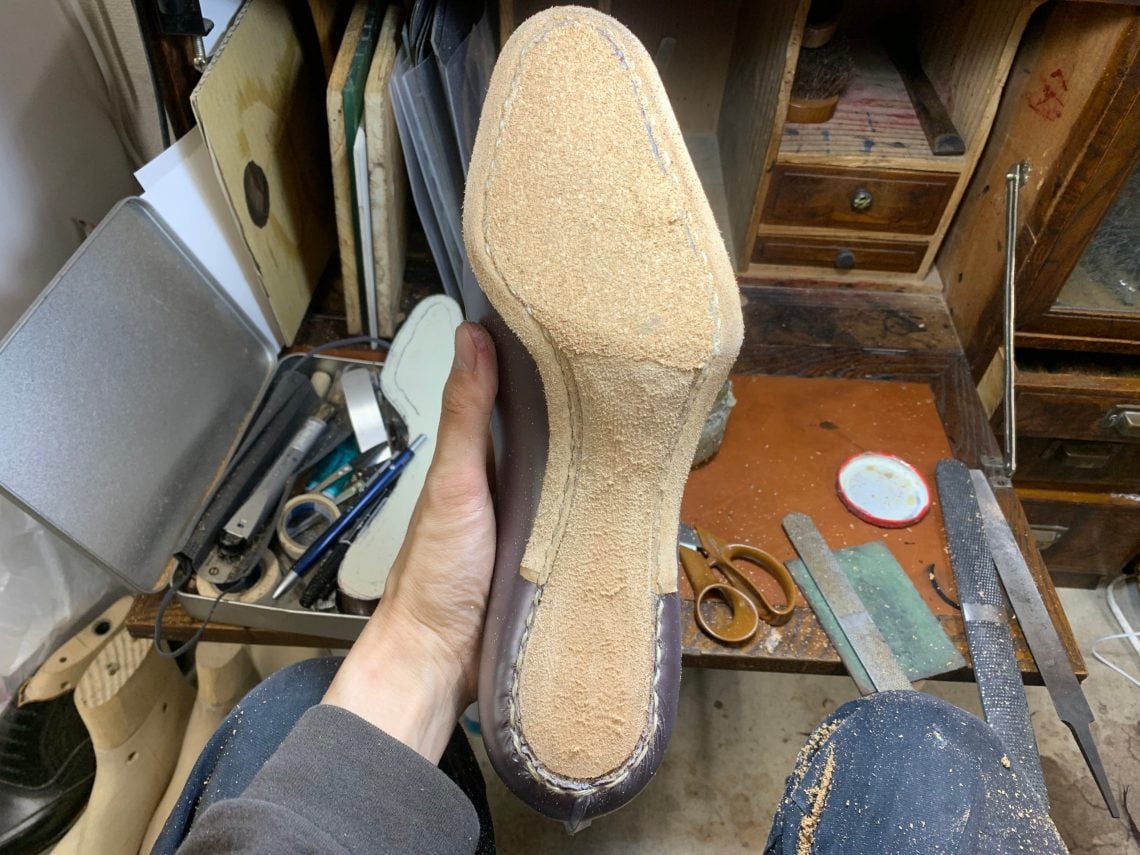












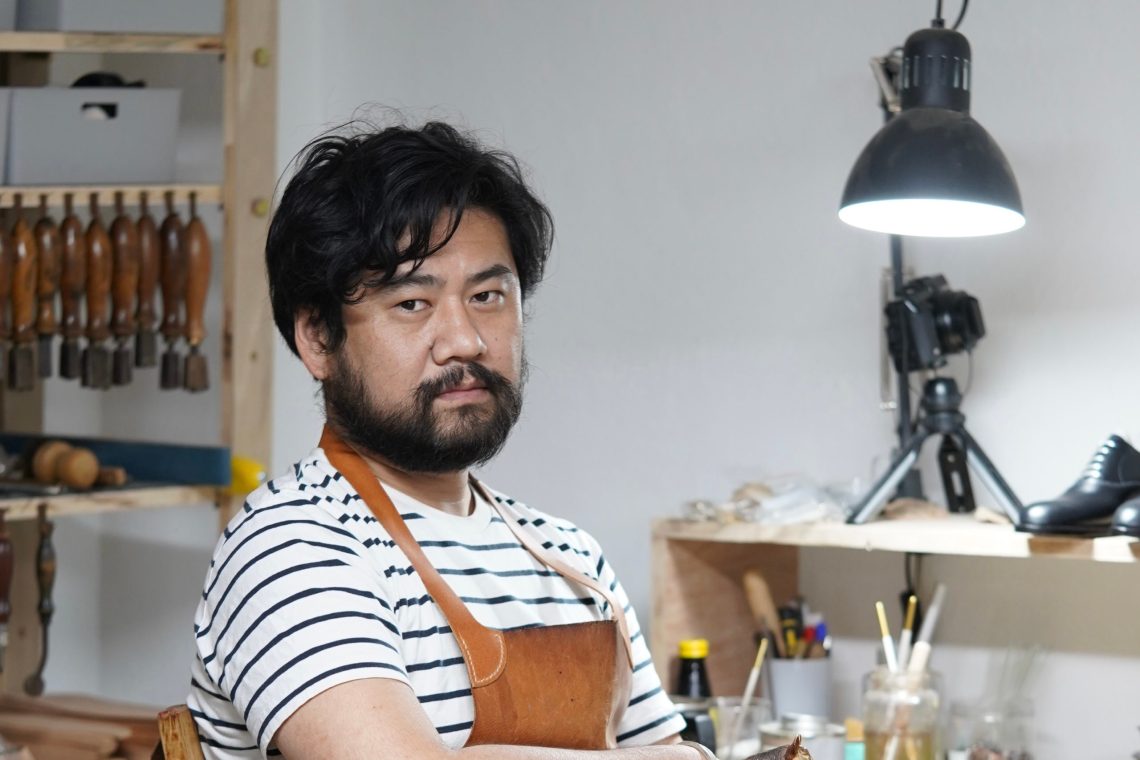














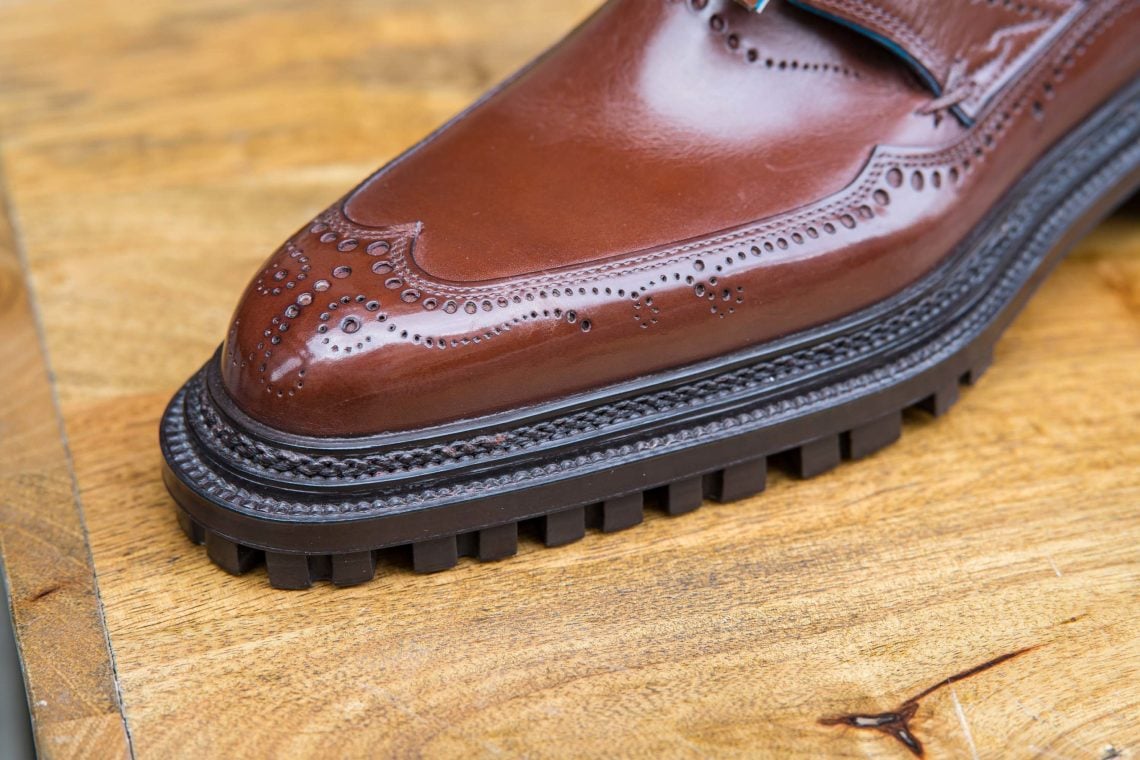





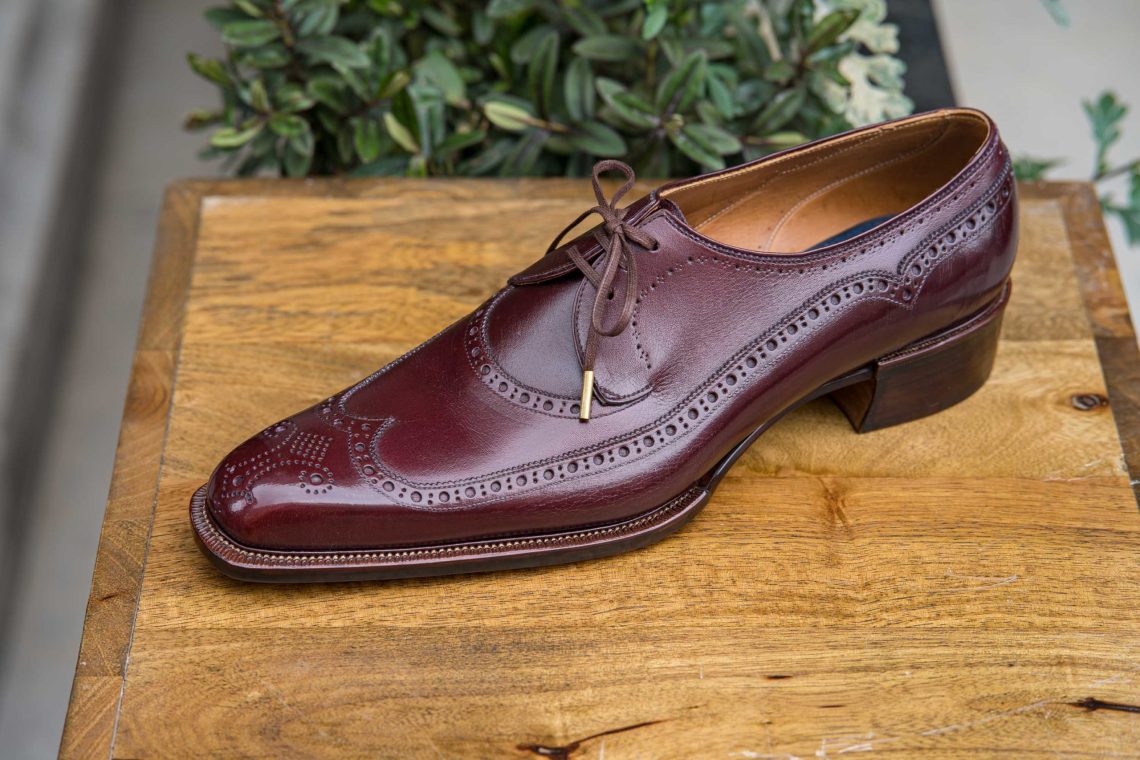
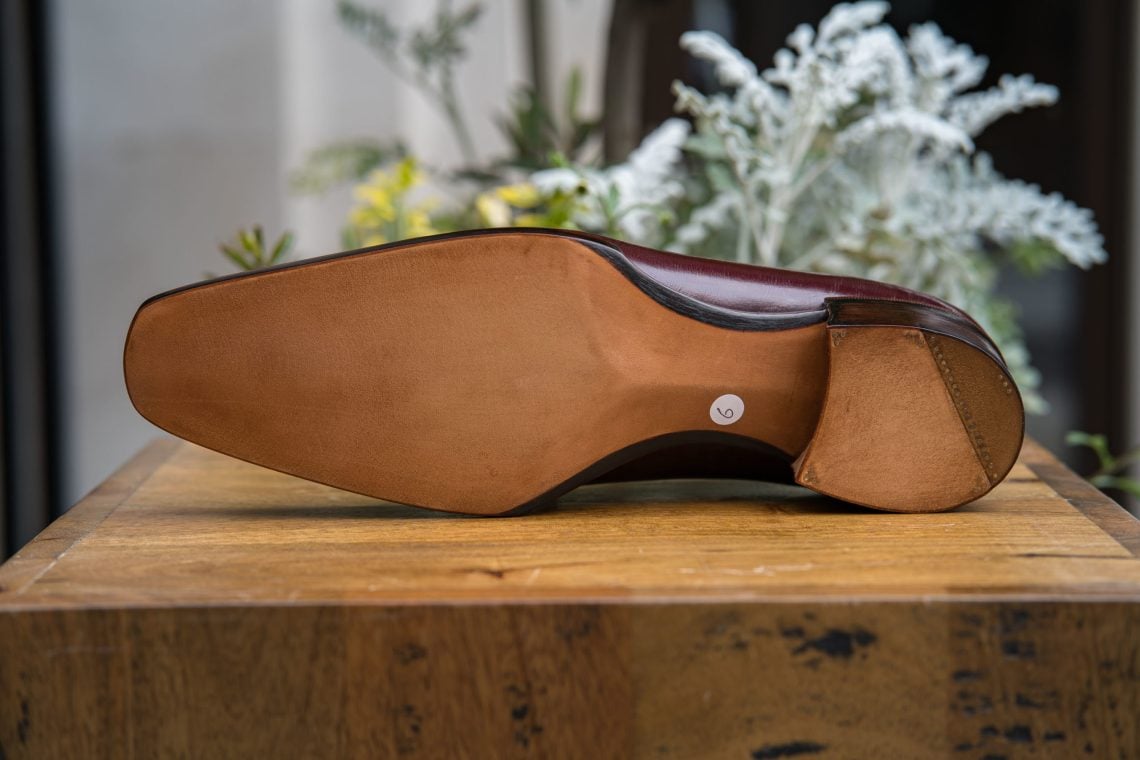


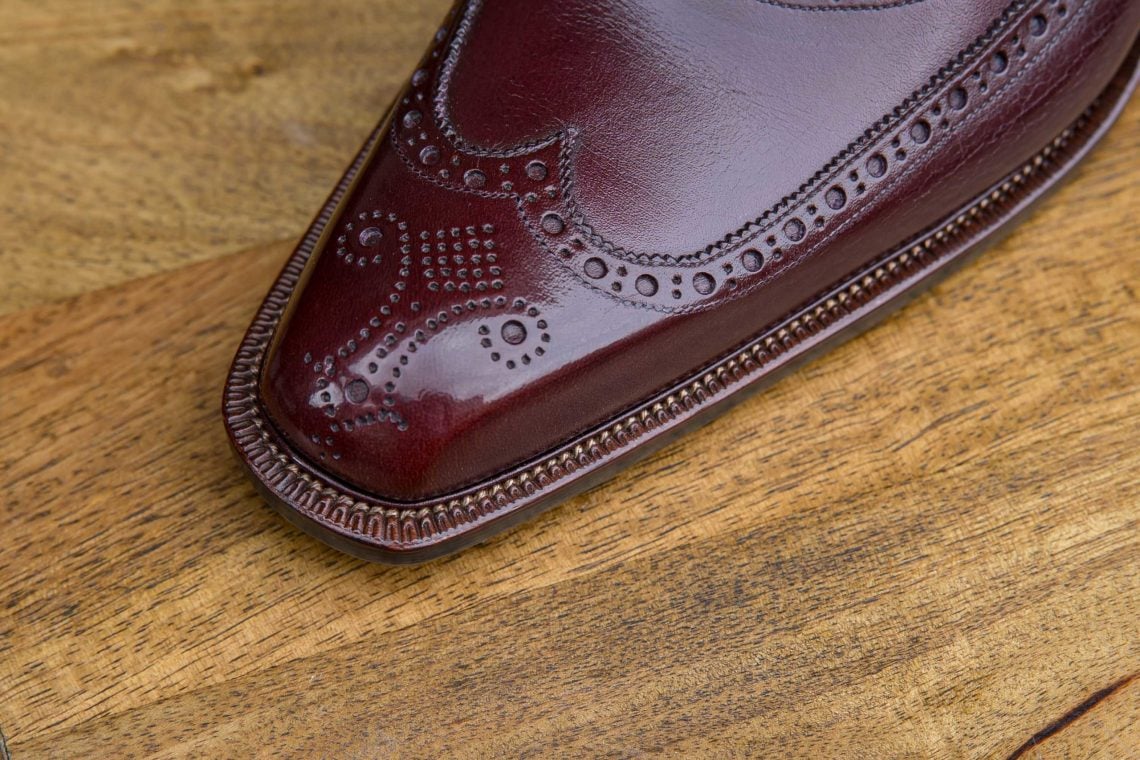
















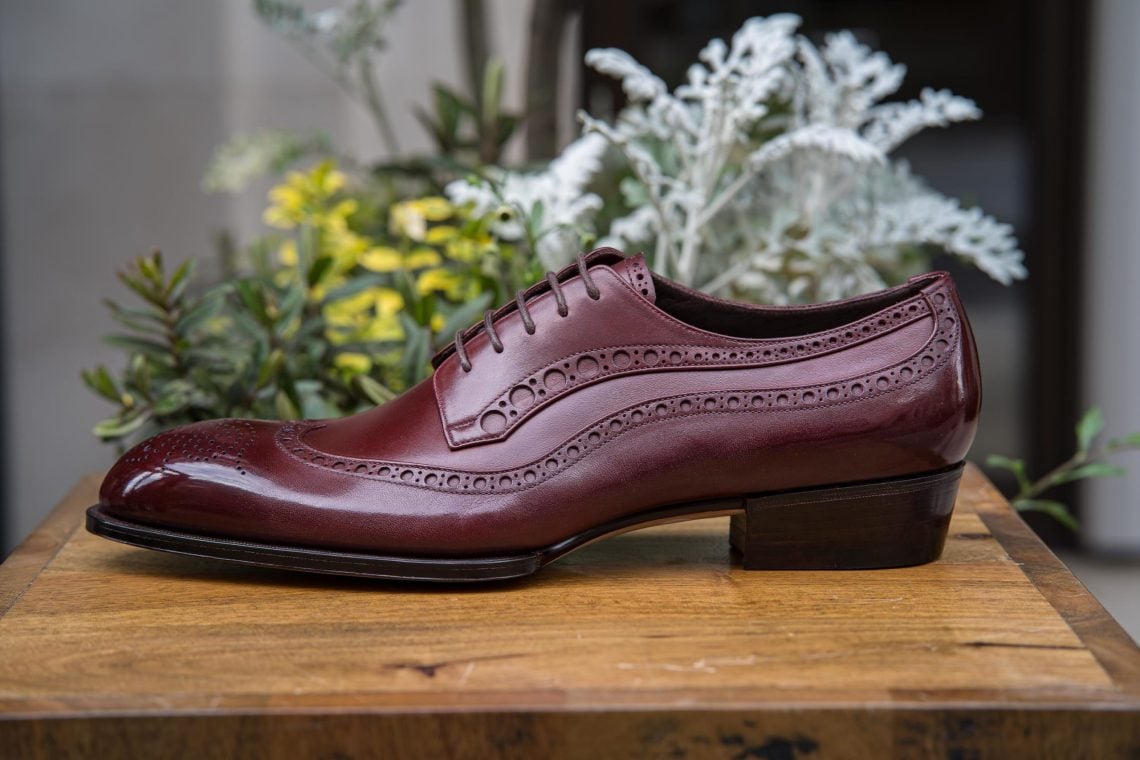








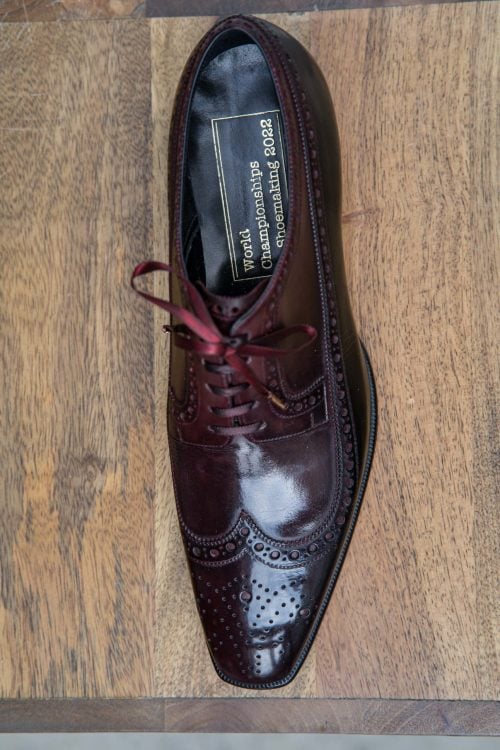



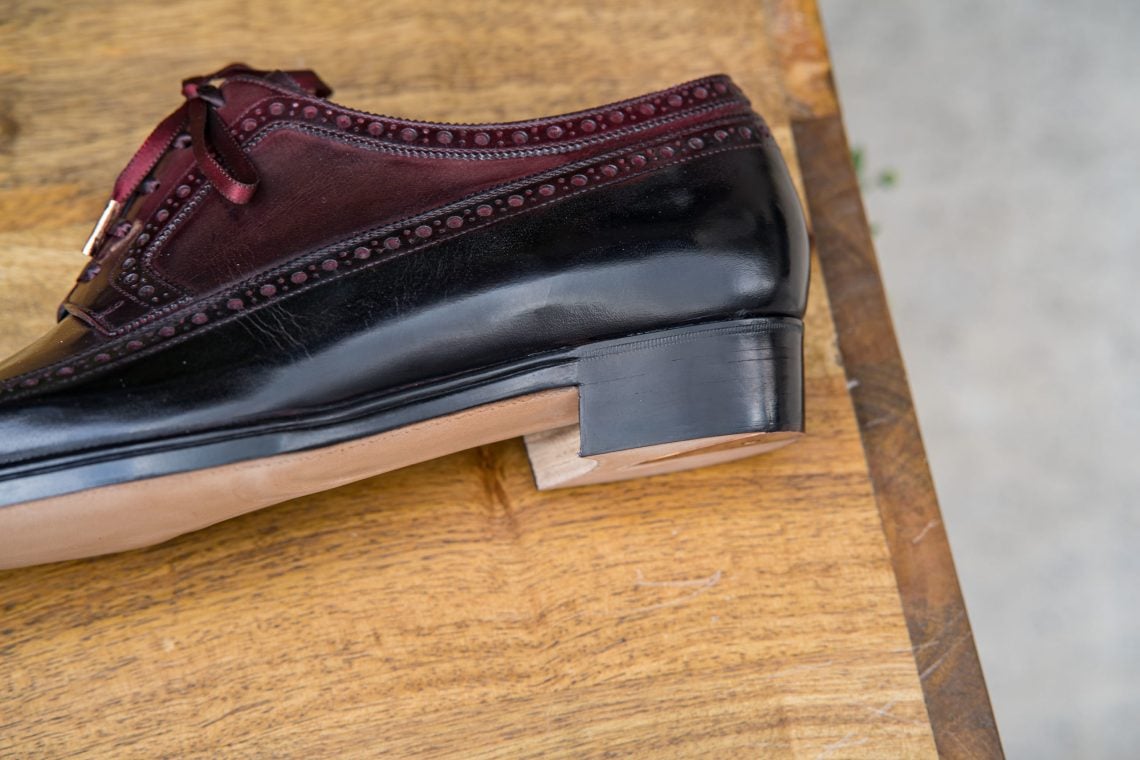


























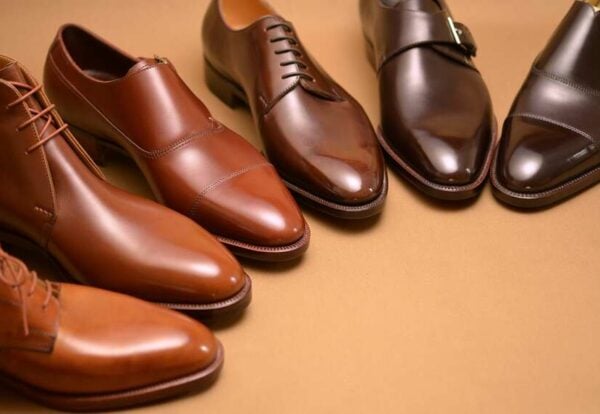







Spectacular!
Amazing shoes and some spectacular show pieces. Great craftsmanship.
Thank you for sharing Oscar